
Garden blooms are gone and foliage is fading in my neighborhood, but a few fruits remain here and there. Some will last through the winter, while others offer happy feasts for birds and critters as winter's cold, icy claw will soon grip the landscape.
As I glance around the garden, the berries, drupes, pomes and other fruits catch my eye amidst the brown and gray of "once lush" trees, shrubs, and forbs. I'll refer you to a list of types of fruits for proper identification.
Can you identify what types of fruits (berries, drupes, pomes, hesperidia, other) are shown here?:
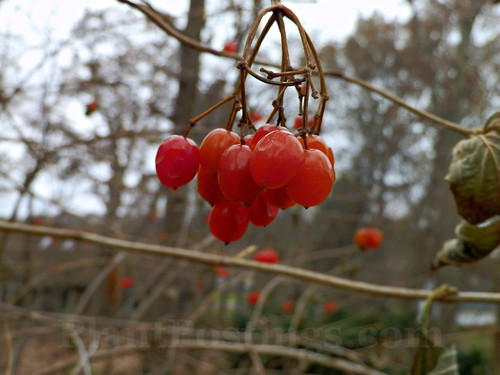
Cranberrybush Viburnum (V. trilobum)

Staghorn Sumac (Rhus typhina)
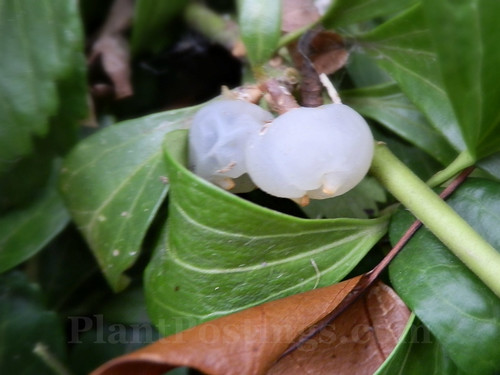
Pachysandra (P. terminalis)
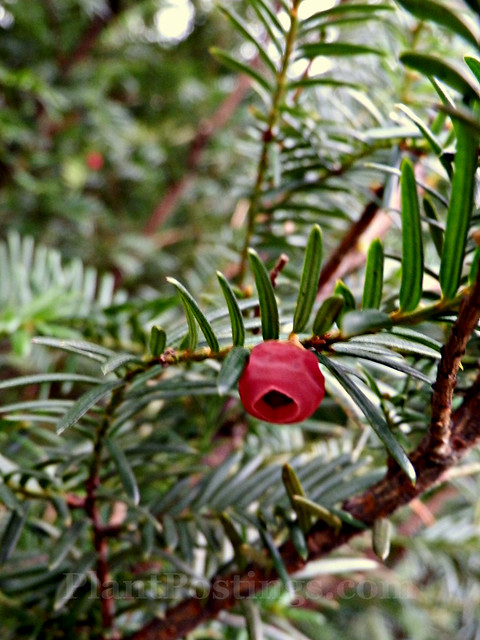
Yew (Taxis canadensis)
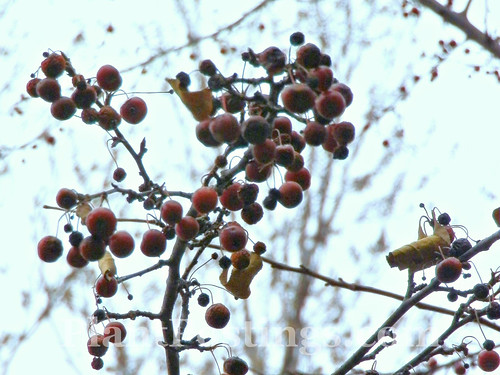
Crabapples (unknown Malus cultivar)
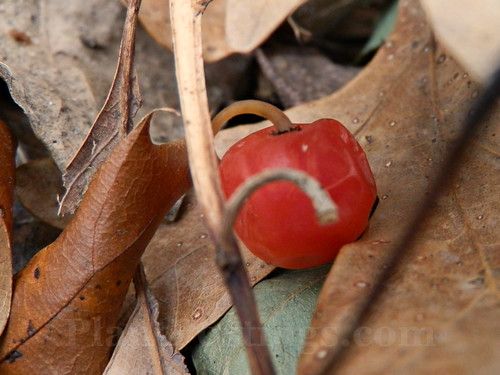
Lily of the Valley (Convallaria majalis)
Those are a few of the outdoor fruits; here are two I overwinter in the sunroom:
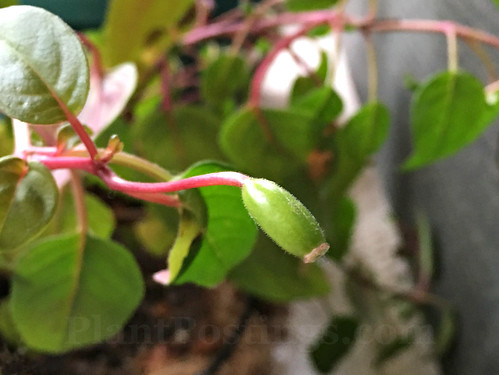
Developing Fuchsia fruit (F. 'Marinka')
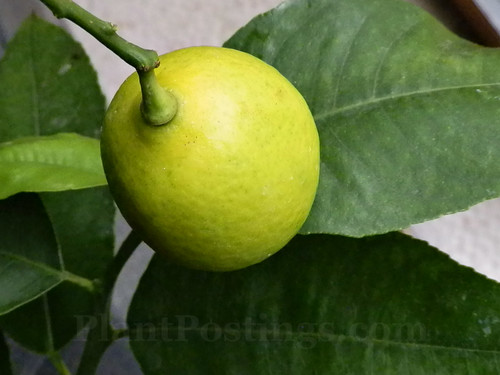
Meyer Lemon (Citrus x meyeri)
Can you correctly classify these fruits? What fruits are growing and ripening in your garden?
[Disclaimer: Not all of the fruits shown here are edible to humans! Research before you consume the parts of any unfamiliar plant!]
Apparently fuchsia fruit is edible, although I’ve never been brave enough to try it!
ReplyDeleteIt's tasty! I didn't know until recently that it was edible: Helene at Graphicality-UK mentioned it. The Fuchsia fruits are sweet and peppery. I don't eat mass quantities of them--mainly because I usually deadhead the spent flowers to encourage more blooms. But when I do occasionally try them, they are tasty. I think the flavor varies by cultivar, though.
Deleteyew berries are my favourite and I always learn something new - lily of the valley from white bells to tiny red fruits
ReplyDeleteI've never eaten the Yew fruits. My understanding is that the seeds are quite poisonous! But the flesh is OK? And the LOV fruits are poisonous to humans, too.
Deletedon't they use yew clippings to harvest a chemotherapy drug?
DeleteHi Diana: I checked, and you are right. Here's an article about using the Pacific Yew to develop Taxol: http://bit.ly/2qodeYo.
DeleteAlmost all fruits and berries have been eaten out of my garden. The holly still has some berries. The Lemon tree has a few lemons still on the tree but that is about it. Everything else gobbled up. Even the rose hips are gone.
ReplyDeleteI'm surprised that I still have so many this year. In particular, I seem to recall that in most years the Viburnum berries would be slim pickings by now. The Sumac always has fruits into spring, and the returning robins seem to favor the old Sumac fruits for some reason. My Lemon tree always perks up in the winter, believe it or not, because it gets more sun when our Oak trees lose their leaves. It lost a lot of leaves, though, when I moved it inside--that happens every year with the shock of the move.
DeleteBerry nice. Thanks for the link! Who knew there were so many different names for various fruits? Here, apples and persimmons dangle like ornaments from now bare tree branches, while holly, cotoneaster, pyracantha, calicarpa, viburnum, and a variety of other berries and seed capsules will brighten the landscape until they're eaten later in the year.
ReplyDeleteI know: I get the types of fruits mixed up. That's why I can't claim to be an expert on the subject! Thank goodness for fruits that brighten the winter landscapes!
DeleteHow pretty that you have those bright spots in the garden to help the transition to wintry days. Must be the time of year since I've been working on a post about some of the fruits in my garden too. Berries have long gone to the birds but I still have some other things to photo and post.
ReplyDeleteHi Shirley: Yes, the fruits do brighten the landscape, even if just a little here and there. I'll look forward to reading and seeing your post! :)
DeleteMost of my berries are just getting started, so it'll be late winter/spring when they're at yummy-for-eating stage. As always, your photos are luscious!
ReplyDeleteThanks, Tina! Some of these are edible for humans, others are not. But there are so many more fruits in the landscape than one realizes—especially on the gray/brown days. ;-) With snow, they visually pop!
DeleteThis is an exciting time of year because when you think all is gone in hibernation, you can still find bright details in some trees like the ones in your photos, that very nice. I like to use them as floral arrangements. Here in Denmark they are masters in creating beautiful "almost winter" ornaments with them!
ReplyDeleteYes, true, Lula! I can only imagine the beautiful Danish ornaments. :) Today, with encouragement from you and others, I pulled together a couple of simple potted arrangements using berries, conifers, pine cones, and other elements. Thanks for the inspiration!
DeleteTechnically the yew is an aril, not a fruit, but with the same purpose. I had nice winter berry and beauty berry fruits, but then migrating birds stopped by for a fill up.
ReplyDeleteGood to know! Thanks! It's interesting to notice how the various berry and fruit counts vary from year to year. Some years, very few Viburnum fruits remain at this point in the season--the squirrels and songbirds take them. Most years, I see many Arisaema fruits throughout the woods. This year, those numbers are switched.
DeleteNice post. The wonderful thing about the changing seasons is that you get to see plants in the garden undergoing transitions, one of them being the production of fruit. Another plant that comes to mind is Calicapra (Beautybush) with its gorgeous purple berries. I just saw some yesterday at teh NY Botanical Garden.
ReplyDeleteThanks, Lee. I agree: Seeing the many stages of the plants is one of the best parts about gardening and studying nature. :) I just planted two Beautyberry shrubs last spring--but their berries were eaten/dried up at the time of this post. They are stunning berries! I will have to include them next year!
DeleteThe barberries and cotoneasters are the main berry bearers in this garden. I always think I want more when this time of year rolls around, then forget about it at planting time.
ReplyDeleteThere are so many wonderful shrubs, trees, and plants with colorful fruits! I know there are more even here on our property that I missed, so I'll have to do another tour to find more. ;-)
DeleteHello Beth, lovely post about a topic close to my heart! Please let me clarify about yew berries: the fleshy part of yew berries are harmless, but the seeds are highly poisonous! Unbroken it will pass through the body without being digested but if the seeds are chewed, poisoning can occur with as few as three berries (in humans).
ReplyDeleteWhen I planted seeds from my Taxus baccata and had to extract the seeds from the berries, I was wearing disposable gloves to be absolutely sure I didn't accidentally get a seed under my finger nails that could later on end up in my mouth. All other parts of yew is also poisonous, so please be careful when pruning and handling - even carrying yew in a pot.
As for fuchsia berries - yes all fuchsia berries are edible, although not all of them are that tasty. I have a miniature fuchsia which produce tiny black berries that taste almost like blueberries. They take patience to pick though lol.
However, after having got another invasion of fuchsia gall mite which affect all parts of the plants, I am no longer so keen on eating any berries. Yuck!
You are lucky Beth for as long as the dreaded pest keeps away from your state.
Hi Helene: Thank you! Yes, it's my understanding that all parts of the Yew are poisonous, except for that little ring of fleshy fruit around the poisonous seed. Don't worry--I don't eat them anyway, and I'm very careful. Regarding the Fuchsias: You are the person who first alerted me to the fact that the Fuchsia berries are edible. I never have enough to really make jam or anything, but I have used a few Fuchsia berries here and there on salads. The 'Markinka' berries are sweet and peppery and a nice topping for salads. Thanks for educating me about them. :)
DeletedHi Beth, don't seem to have any edible berries in my garden at the moment, so I'll go to the market to buy yummy raspberries and enjoy looking at your impressive variety.
ReplyDeleteI should have started this post by saying not all of these berries are edible (or tasty) for humans! Note that I added a disclaimer at the end. I leave most of the berries shown here to the birds and wildlife. And I much prefer raspberries and other seasonal fruits (apples, Florida citrus, pears, etc.) that are available now. ;-) Enjoy the fruits of your locale!
DeleteI didn't realize that lily of the valley had berries on it - must inspect my patch out front! We have a vine the covers one of our pergolas - I think it may be bittersweet - that is so pretty at this time of year with it's orange/red berries.
ReplyDeleteOh, yes, I've seen Bittersweets in this area, too--they are very pretty. Most of my LOV plants are covered with Oak leaves now, but lifting the leaves, you can see the occasional berries here and there. Now that winter is hitting with full force, those little berry finds will be treasured by our bird and mammal friends. :)
DeleteHuh! Some interesting ones here that are new to me. Now I want a Sumac bush.
ReplyDeleteYes, the Sumac has been at the side of our driveway since we moved in. I've cut it back drastically several times, and it keeps regenerating. I didn't realize the robins ate the berries until recently--when I saw one on the shrub. Also, this is the first year I've seen a Monarch nectaring on the Sumac flowers. I think it's because the timing was right this year--the Monarchs got here so early in June. Anyway, that was a beautiful sight to see--one of the Monarchs I rescued nectaring on the Sumac. :)
DeleteAn interesting post and a lot of knowledge in it. * I am already after a painful surgery at home and I try to practice a lot to get back to fitness as soon as possible. Regards.
ReplyDeleteThanks, Giga. I hope your recovery will be speedy and you'll be feeling much better soon. Thanks for visiting. Happy Holidays and best wishes for health and happiness!
DeleteSo nice to see an abundance of foods for the birds and animals of Winter. I have many of the same here in the garden. There is always life in gardens, even in the dead of winter.
ReplyDeleteYes, I'm glad there are many berries this year for the birds and wildlife. Some years, it seems they eat them much earlier in the season. It's so fun to watch the birds at the feeders all winter long.
DeleteAn abundance of beautiful blooms! I didn't realize Lily of the Valley did anything after the white blooms, either. Are you ready for the deep freeze we're predicted for this week? I'm not. Brrr.
ReplyDeleteHi Karen: It's surprising how many berries are still available in the landscape. No, I am not ready for the deep freeze that started today. Gosh, that was brutal--going from a high of 60 on Monday to windy and the 30s today! Brrrrr is right! I see that NW Wisconsin got quite a bit of snow. I'm not ready for that either!
DeleteHi,
ReplyDeleteI did not know that Lily of the Valley had a fruit. I will have to go look at mine.
No snow yet up here in Wisconsin. A cold front is moving in.
Hi Carla: Yep, I've noticed the LOV fruits from time to time. I think the critters eat most of them. Most of the fruits shown on this post are not best for human consumption, but it's nice that they're available for the birds and the mammals. Re: the snow--I see that NW Wisconsin got a few inches overnight. I'm not ready for that!
DeleteThe berries on my arrowwood and beautyberry shrubs are long gone. (Last year, the beautyberries lasted until December, but this year the birds cleaned out the shrub much sooner.)
ReplyDeleteI still have plenty of red chokeberries (Aronia arbutifolia). The shrub is tough, the berries are beautiful and the birds must not like them any more than I do because they hang on the shrub until late winter before somebody (last year, a robin) decides to eat them.
There are a few berries on my young exotic Needlepoint hollies, but the birds don't seem interested in those either.
The Juniperus virginiana trees are loaded with cones/berries and the biggest wax myrtle has oodles of berries too. Last year, I didn't notice when the birds cleaned out that shrub. One time I looked there were lots of berries, next time there were none. So I'm going to try to be more observant this year to see when the birds arrive to harvest those fruits.
Gosh, I guess I should get outside and take some fruit photos!
Thanks for the great pics as usual. Happy Holidays!
Aaron
Hi Aaron: I just planted two Beautyberry shrubs and an Aronia this year! They're both tiny shrubs to start, but the Beautyberries bloomed and produced fruit in the first year. The purple fruits were so lovely, but they shriveled up after the first cold blast. Sounds like you have quite a few fruits. I'll look forward to your posts about them! :)
Delete